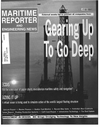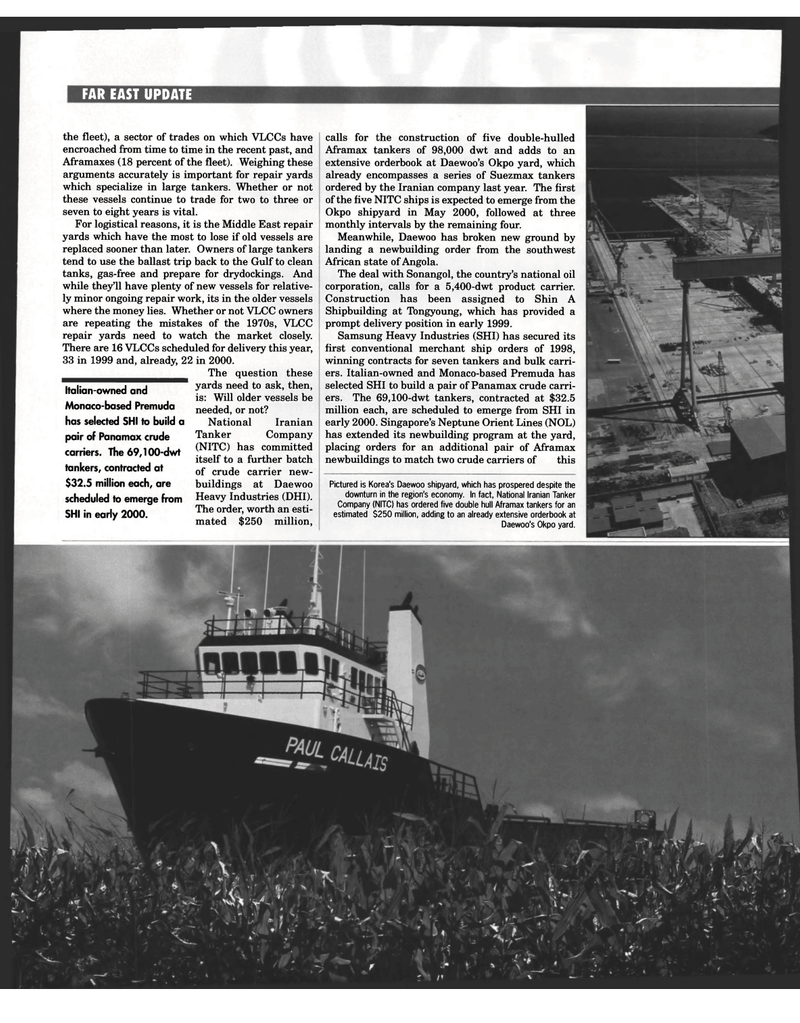
Page 38: of Maritime Reporter Magazine (April 1998)
Read this page in Pdf, Flash or Html5 edition of April 1998 Maritime Reporter Magazine
FAR EAST UPDATE the fleet), a sector of trades on which VLCCs have encroached from time to time in the recent past, and
Aframaxes (18 percent of the fleet). Weighing these arguments accurately is important for repair yards which specialize in large tankers. Whether or not these vessels continue to trade for two to three or seven to eight years is vital.
For logistical reasons, it is the Middle East repair yards which have the most to lose if old vessels are replaced sooner than later. Owners of large tankers tend to use the ballast trip back to the Gulf to clean tanks, gas-free and prepare for drydockings. And while they'll have plenty of new vessels for relative- ly minor ongoing repair work, its in the older vessels where the money lies. Whether or not VLCC owners are repeating the mistakes of the 1970s, VLCC repair yards need to watch the market closely.
There are 16 VLCCs scheduled for delivery this year, 33 in 1999 and, already, 22 in 2000.
The question these
Italian-owned and
Monaco-based Premuda has selected SHI to build a pair of Panamax crude carriers. The 69,100-dwt tankers, contracted at $32.5 million each, are scheduled to emerge from
SHI in early 2000. yards need to ask, then, is: Will older vessels be needed, or not?
National Iranian
Tanker Company (NITC) has committed itself to a further batch of crude carrier new- buildings at Daewoo
Heavy Industries (DHI).
The order, worth an esti- mated $250 million, calls for the construction of five double-hulled
Aframax tankers of 98,000 dwt and adds to an extensive orderbook at Daewoo's Okpo yard, which already encompasses a series of Suezmax tankers ordered by the Iranian company last year. The first of the five NITC ships is expected to emerge from the
Okpo shipyard in May 2000, followed at three monthly intervals by the remaining four.
Meanwhile, Daewoo has broken new ground by landing a newbuilding order from the southwest
African state of Angola.
The deal with Sonangol, the country's national oil corporation, calls for a 5,400-dwt product carrier.
Construction has been assigned to Shin A
Shipbuilding at Tongyoung, which has provided a prompt delivery position in early 1999.
Samsung Heavy Industries (SHI) has secured its first conventional merchant ship orders of 1998, winning contracts for seven tankers and bulk carri- ers. Italian-owned and Monaco-based Premuda has selected SHI to build a pair of Panamax crude carri- ers. The 69,100-dwt tankers, contracted at $32.5 million each, are scheduled to emerge from SHI in early 2000. Singapore's Neptune Orient Lines (NOL) has extended its newbuilding program at the yard, placing orders for an additional pair of Aframax newbuildings to match two crude carriers of this
Pictured is Korea's Daewoo shipyard, which has prospered despite the downturn in the region's economy. In fact, National Iranian Tanker
Company (NITC) has ordered five double hull Aframax tankers for an estimated $250 million, adding to an already extensive orderbook at
Daewoo's Okpo yard.

 37
37

 39
39
